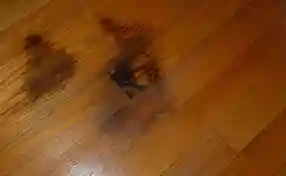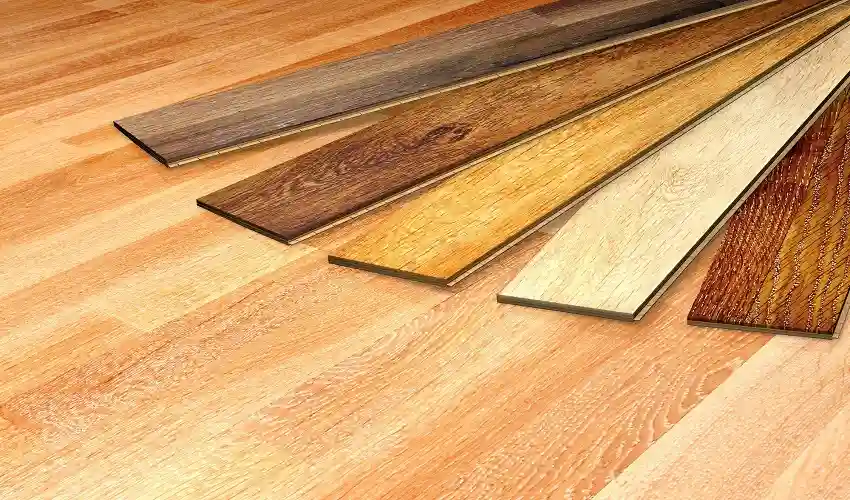Black marks on wood floors look bad. They make your home feel dirty. You can fix them yourself or hire someone. This guide shows you both ways.
What Makes Black Stains on Wood Floors

Black spots come from many things. Water is the main problem. Pet mess also causes dark marks. Old spills turn black over time.
Main Reasons for Black Marks
- Water sits too long on floors
- Dogs and cats have accidents
- Metal things rust and stain wood
- Food and drinks spill and stay wet
- Dirt gets ground into the wood
- Shoes track in mud and oil
- Steam from cooking settles on floors
- Leaky pipes drip water for days
Different Kinds of Black Stains
- Light stains on top of wood finish
- Deep stains that go into the wood
- Old stains that spread wide
- Chemical stains from cleaning products
- Heat stains from hot pans or irons
- Ink stains from pens and markers
Fix Black Stains Yourself at Home
You can remove many black stains at home. This costs less money. You need simple things from the store.
What You Need to Start
- White vinegar from the kitchen
- Baking soda for cleaning
- Hydrogen peroxide from the medicine cabinet
- Clean rags and old towels
- Rubber gloves to protect hands
- Small brush for scrubbing
- Bucket for mixing water
- Paper towels for drying
Way 1: Use Hydrogen Peroxide
This clear liquid works great on water stains. You can buy it at any drug store. It costs about two dollars.
How to Do It:
- Put on rubber gloves first
- Clean the stain with soap and water
- Dry the area with a clean towel
- Pour hydrogen peroxide on a rag
- Press the wet rag on the black mark
- Leave it there for one hour
- Check if the stain got lighter
- Do it again if you need to
Good Things:
- Costs very little money
- Safe for most wood floors
- Works fast on water marks
- Easy to find at stores
Bad Things:
- Might take many tries
- Can make wood lighter in color
- Does not work on very old stains
- Smells strong while working
Way 2: Try White Vinegar
Vinegar cleans and kills germs. It also removes bad smells. Mix it with water to make it gentle.
Steps to Follow:
- Mix half vinegar and half water
- Test it on a hidden spot first
- Dip a cloth in the mix
- Rub it on the dark stain gently
- Let it sit for ten minutes
- Wipe clean with plain water
- Dry with a soft towel
Why It Works:
- All natural ingredients
- Removes pet smells
- Kills bacteria and mold
- Safe around kids and pets
- Costs under one dollar
Things to Know:
- Smells like pickles at first
- May not work on tough stains
- Can make shiny floors look dull
- Takes time to see results
Way 3: Make Baking Soda Paste
Baking soda scrubs stains away. Mix it with water to make a thick paste. This works on scuff marks too.
How to Make It:
- Take two spoons of baking soda
- Add one spoon of warm water
- Mix until it looks like toothpaste
- Spread it on the black mark
- Rub in small circles
- Wait twenty minutes
- Wipe away with a damp cloth
- Dry the floor completely
What Makes It Good:
- Very cheap to use
- Does not hurt kids or pets
- Scrubs away surface dirt
- Makes floors smell fresh
Watch Out For:
- Can scratch soft wood finishes
- Only works on top stains
- Takes elbow grease to rub
- Leaves white powder if not cleaned well
Way 4: Sand the Stain Away
Light sanding removes the top layer of wood. This gets rid of stains in the finish. Only do this on small spots.
What You Need:
- Fine sandpaper (220 grit)
- Dust mask for breathing
- Small sanding block
- Tack cloth for cleaning
- Wood stain that matches
- Clear finish to protect
Steps:
- Put on your dust mask
- Sand with the wood grain only
- Use light pressure
- Check your progress often
- Clean dust with tack cloth
- Apply matching stain if needed
- Put on clear finish to protect
Way 5: Try Store-Bought Wood Bleach
Wood bleach is stronger than household items. It can remove deep stains. Be very careful when using it.
Safety First:
- Open windows for fresh air
- Wear gloves and eye protection
- Read all directions twice
- Keep pets and kids away
- Have water ready in case of spills
How to Use:
- Sand the stain lightly first
- Apply bleach with a brush
- Follow the time on the bottle
- Wash off with clean water
- Let dry for twenty four hours
- Sand smooth when dry
- Stain and finish to match
Get Professional Help Instead
Pros have better tools and know more tricks. They cost more but work faster. They guarantee their work too.
When to Call the Pros
- You tried DIY and it did not work
- Stains cover a big area
- Your floors cost a lot of money
- You need it done fast
- Insurance will pay for it
- The wood is very old or special
- You are not handy with tools
- Previous owner left big stains
What Pros Can Do That You Cannot
Professionals have machines you cannot buy. They know secrets about different woods. They can match colors perfectly.
Special Tools They Use:
- Big sanders that work fast
- Dust systems that catch everything
- Strong chemicals not sold in stores
- Moisture meters to check wetness
- Color matching computers
- Spray guns for smooth finishes
Special Skills They Have:
- Know different types of wood
- Can tell how deep stains go
- Fix boards that are too damaged
- Match old finishes exactly
- Know which products work best
- Can work around furniture
How Pros Remove Black Stains
Professional work follows steps. They test first. Then they make a plan. Finally they do the work.
First Visit:
- Look at all the stains
- Test the wood moisture
- Figure out what caused stains
- Measure the whole area
- Give you a price quote
- Schedule the work day
Prep Day:
- Move furniture out of the way
- Cover things to protect from dust
- Set up dust collection machines
- Clean the floor completely
- Mark areas that need extra work
Work Days:
- Sand off old finish if needed
- Apply stain removal products
- Bleach wood where required
- Sand smooth between coats
- Apply new stain to match
- Put on protective finish coats
- Clean up all dust and mess
What Professional Work Costs
Pro work costs more up front. But it lasts longer. Prices change by area and job size.
Cost Factors:
- Size of the room or house
- How bad the stains are
- Type of wood you have
- What finish you want
- Where you live
- How much furniture to move
Typical Prices:
- Small bathroom: $200 to $500
- Bedroom: $400 to $800
- Living room: $600 to $1200
- Kitchen: $500 to $1000
- Whole house: $2000 to $6000
- Just stain removal: $100 to $300 per room
Extra Costs:
- Moving heavy furniture: $50 to $200
- Replacing damaged boards: $5 to $15 per board
- Special stain matching: $100 to $300
- Rush jobs: 25% more than normal
- Weekend work: 50% more than weekdays
DIY vs Professional Methods: Which Is Better
Both ways can work. Your choice depends on money, time, and how bad the stains are.
DIY Works Best When
- Stains are new and light
- You have more time than money
- The stained area is small
- You like doing projects yourself
- You can live with okay results
- The floors are not expensive
- You want to learn something new
Pros Work Best When
- Stains are old and deep
- Your floors cost a lot of money
- You tried DIY and it failed
- You need perfect results
- Time is more important than money
- You have insurance to pay
- The whole floor needs work
Money Comparison
DIY Costs:
- Supplies: $10 to $50
- Tools you might need: $20 to $100
- Your time: 5 to 20 hours
- Mistakes can cost more later
- May need pro help anyway
Professional Costs:
- Higher price up front
- Work done in 1 to 3 days
- Results guaranteed
- No tool buying needed
- Lasts longer than DIY
Time Comparison
DIY Time:
- Research what to do: 2 hours
- Shop for supplies: 2 hours
- Do the actual work: 4 to 12 hours
- Wait for things to dry: 1 to 3 days
- Redo if it does not work: Extra time
Professional Time:
- Get quotes: 2 to 4 hours total
- Wait for appointment: 1 to 2 weeks
- Actual work time: 1 to 3 days
- Ready to use right away
- No extra trips or redos
How to Choose the Right Way
Think about these things before you decide. The right choice is different for everyone.
Look at Your Stains First
New Stains:
- Happened in the last month
- Still look wet or damp
- Have not spread wider
- Came from water or food
- Easy to see what caused them
Old Stains:
- Been there over six months
- Look dry and set in
- Have spread into the wood grain
- You do not know what caused them
- Previous cleaning made them worse
Size Matters:
- Few small spots: Try DIY first
- Many spots: Consider pros
- Whole rooms: Pros work faster
- Just one big stain: DIY might work
- Throughout the house: Call pros
Think About Your Skills
Good DIY Candidates:
- You fix things around the house
- You have used wood stain before
- You read directions carefully
- You have patience for slow progress
- You do not mind if results are not perfect
Should Call Pros:
- You have never worked with wood
- You want it to look like new
- You tried before and made it worse
- You do not have the right tools
- You need it done by a certain date
Consider Your Budget
Tight Budget:
- Try DIY methods first
- Start with cheapest options
- Do one small area as a test
- Save pro money for worst stains
- Learn as you go
More Money Available:
- Get pro quotes first
- Compare to DIY time and effort
- Think about long term value
- Consider your time worth something
- Factor in guarantee of pro work
Stop Black Stains Before They Start
Preventing stains costs less than fixing them. Simple habits keep floors looking good.
Daily Habits That Help
- Clean up spills right away
- Take shoes off at the door
- Use mats where people walk most
- Keep humidity between 30 and 50 percent
- Check for leaks around sinks and toilets
- Train pets to go outside
- Wipe up water after baths
- Use coasters under drinks
Monthly Floor Care
- Sweep and mop with wood floor cleaner
- Check for new stains or damage
- Move furniture to clean under it
- Look for loose boards or squeaks
- Test moisture levels in basements
- Clean or replace air filters
- Check weather stripping on doors
Yearly Deep Cleaning
- Have pros clean and check floors
- Fix small problems before they get big
- Re apply protective finish if needed
- Check for insect damage or rot
- Update insurance photos of floors
- Consider refinishing high traffic areas
Make Your Final Choice
Your decision between DIY vs Professional Methods for Black Wood Flooring Stain Removal comes down to what matters most to you.
Choose DIY When You Want To:
- Save money on the work
- Learn new skills
- Work on your own schedule
- Try different methods
- Accept that results may vary
- Take time to do it right
- Feel proud of doing it yourself
Choose Professionals When You Need:
- Perfect results that match exactly
- Work done fast and right the first time
- Someone else to handle problems
- Insurance documentation
- Warranty on the work
- No risk of making stains worse
- To save your time for other things
Best of Both Worlds
Some people mix both approaches:
- Try DIY on hidden areas first
- Use pros for the worst stains
- Get pro advice but do work yourself
- Have pros fix your DIY mistakes
- Learn from pros for future projects
Conclusion
Black stains happen to everyone but you can fix them. DIY methods work great for new water stains using vinegar or hydrogen peroxide. Professional help handles deep old stains better. Try DIY on small areas first. Call pros for large damage or valuable floors. Prevention through quick spill cleanup beats any removal method. Choose based on your budget, time, and stain severity for best results.






